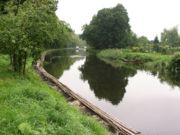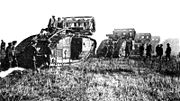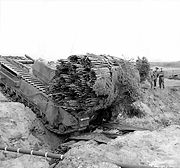
Fascine
Encyclopedia

Erosion
Erosion is when materials are removed from the surface and changed into something else. It only works by hydraulic actions and transport of solids in the natural environment, and leads to the deposition of these materials elsewhere...
, covering marshy ground and so on.
Early military use
Such "fascine" bundles were used in military defences for revetting (shoring up) trenches or ramparts, especially around artilleryArtillery
Originally applied to any group of infantry primarily armed with projectile weapons, artillery has over time become limited in meaning to refer only to those engines of war that operate by projection of munitions far beyond the range of effect of personal weapons...
batteries, or filling in ditches from earliest military actions. Military fascine bridges were used on a regular basis by the Romans to cross obstacles. Subsequently the use of fascines by military engineers continued almost wherever armies were deployed.
Military fascine in WW1 and WW2


Modern military fascine post WW2
The modern pipe fascine was developed in the British Army in the early 1980s to meet the challenges of assuring the mobility of movement in West Germany in the event of a conflict with the Warsaw Pact.This requirement stemmed from the terrain of West Germany where the majority of obstacles to mobility run north – south and movement by military forces would have been east – west. Thus this terrain naturally presented many obstacles to mobility. The most significant obstacles were those that would block movement of armour; primarily rivers, canals and other gaps in excess of 3m wide and more than 2m deep.
The larger gaps, rivers or canals, were to be crossed using bridges or ferries. The bridges or ferries would be hand assembled on the crossing sites in the areas to the rear of the combat zone. But gaps at the forward edge had to be bridged with armoured vehicles and the bridges launched without exposing the crew. This was achieved using the AVLB (Armoured Vehicle Launched Bridge). These could bridge gaps, from 5 m – 24.5m but, due to their expense, low numbers in service and need for frequent redeployment for use on other large gaps over 10m they could not viably be used on the numerous smaller gaps, from 3 – 10m.
The problem was that within the area of operation of the British Army, near Hannover, there is a significant number of smaller gaps, mainly drainage ditches, streams and small rivers approximately 5-10 m wide and 1.5 – 2.5 m deep that are sufficient to stop armoured vehicles. Given the low number of AVLBs available a solution was needed to bridge these gaps quickly and cheaply and, if required, under fire.
In World War I similar dry gaps, i.e. large trenches, had been bridged using wooden fascines and investigations started on using modern versions of these. However it soon became clear that these were ineffective for use with the much heavier modern vehicles of up to 70 tons, 3 – 4 times heavier than World War I vehicles. The modern vehicles quickly reduced the wood in the fascines to splinters and became ineffective. Further, many of the gaps in Germany had running water in them so wooden fascines were likely to float and not stay in position. The equipment also had to have the capability to be used in rapidly bridging anti tank ditches in assault operations in other operational scenarios.
The Royal Engineers Experimental Establishment at Christchurch did initial tests on the possible use of 9” high density plastic pipes held together with chains as an alternative that would allow water flow and not be damaged with the higher modern vehicle weight.
The further development of this concept was handed over to Lt C Roebuck RE
Chris Roebuck
Chris Roebuck, BSc, MBA, FCIPD, FCMI is a British economist who lectures on leadership topics and advises organisations on maximising performance through effective leadership, in particular developing lean leadership and entrepreneurial leadership. Roebuck has held senior Human Resource and...
and his troop, 5 Troop, 31 Armoured Engineer Squadron, 32 Armoured Engineer Regiment at Munsterlager, North Germany in 1982. The Centurion AVRE was a Centurion tank derivative with a bulldozer blade and 165mm demolition gun fitted.
The Troop built a number of testing prototypes in Germany for development into an effective operational solution that could be accepted into service and used across the Army by both Royal Engineer and other armoured units as required. The fascines were to be launched from with the Combat Engineer Tractor or the Centurion AVRE but also with options for deployment from other vehicles. The front of the AVRE was modified by the addition of a tilting cradle above the drivers compartment to take the fascine.
The trials involved a large number of test launches across multiple sites and a wide variety of situations to develop the structure and delivery of the fascine in operations, i.e. to find the optimum number of pipes and chain tension to create an effective level surface for vehicles in gaps, to ensure accurate deployment, rapid recovery and re deployment techniques or to test multiple launches for wider gaps. Vehicles in “shut down” combat mode and night time launches with no lights were also tested to simulate operational conditions. In “wet” gaps differing speeds and volumes of running water in the gap were tested for their impact on the fascines.
The launch technique was to approach the target gap at speed, brake sharply at a marked point and fire the explosive bolts holding the travel hawsers so that the fascine, through inertia, rolled off the AVRE directly into the middle of the gap. When in position the AVRE would then travel over it to level the road surface for other vehicles to cross. This whole process would take less than 1 minute, essential for an assault crossing possibly under fire.
Over a number of months the fascine was tested and developed, modifications were made, e.g. inserting splitable shackles in the chain holding the fascine together to allow rapid repair and tensioning, nets on the end of pipes to prevent pipes being pushed out by waterborne debris. The tests showed that with experienced drivers and crew up to 3 fascines could be launched in combination to bridge significant gaps, however this was restricted to 2 for safety reasons when using non ARVE crews. The night time testing of these was the most dangerous part of the trial with the risk of the AVRE tipping off the fascine into the gap, especially where it was a deep water gap.
After 6 months of hard work and innovative ideas from all ranks to refine the system the development trial was concluded and the final design, user hand book and acceptance recommendations were submitted by Chris Roebuck
Chris Roebuck
Chris Roebuck, BSc, MBA, FCIPD, FCMI is a British economist who lectures on leadership topics and advises organisations on maximising performance through effective leadership, in particular developing lean leadership and entrepreneurial leadership. Roebuck has held senior Human Resource and...
in November 1982. The fascine was subsequently accepted into service and used successfully in a number of operational and non operational roles. It was used in combat for the first time during the First Iraq war to breach anti tank ditches using the more recent Chieftain AVRE. It is now in regular use by the British Army and other armies as an effective aid to rapid crossing of small obstacles.
Currently, the British army uses the ChAVRE - an engineering vehicle based on the Chieftain tank
Chieftain tank
The FV 4201 Chieftain was the main battle tank of the United Kingdom during the 1960s and 1970s. It was one of the most advanced tanks of its era, and at the time of its introduction in 1966 had the most powerful main gun and heaviest armour of any tank in the world...
- to carry and deploy pipe fascines. This is due to be replaced by the Trojan
Trojan (vehicle)
The Trojan armoured fighting vehicle can breach minefields and be used for many other tasks. It is currently in use with the Royal Engineers of the British Army.-Design:It is based on a Challenger 2 tank chassis, but lacks the main armament...
, based on the Challenger 2 tank.Current 32 Armoured Engineer Regiment operation.

